Because people have been playing Chess for a very long time, and even playing Chess by the modern rules for a very long time (by this I do not mean by the exact current rules of Chess, but simply Chess with the modern moves of the Queen and the Bishop), a considerable body of knowledge has been amassed concerning the various specific sequences of moves with which the game can begin.
These Chess openings are known by name, and so a list of a few of the openings you might be most likely to hear mentioned seems to me like something that might be useful, although it must be admitted that there are many books and even websites with far more complete lists than the one that will be offered here.
Although the chess federations of all the English-speaking nations have abandoned descriptive notation for the worldwide standard of algebraic notation, I will be listing the moves of the openings in both forms.
In addition, as a special bonus, although many books on Chess in Spanish, even in the 19th Century, used algebraic notation, I am also giving the moves of the openings in Spanish descriptive notation. Naturally, this uses the names of the pieces in Spanish as its basis:
P Peon Pawn P Pion R Rey King R Roi D Dama Queen D Dame A Alfil Bishop F Fou C Caballo Knight C Cavalier T Torre Rook T Tour
and a move like P-QB3 becomes P3AD - Pawn to the third square of the Bishop of the Queen - in that system of notation.
French descriptive notation - quite rarely used - works on a similar basis, and so the names of the pieces in French are in the third column: here, P-QB3 becomes P.3FD, so the order of elements is the same as in Spanish descriptive notation, but as in English descriptive notation, the letter for the piece being moved is followed by a punctuation mark, but a period instead of a dash.
The transformation being trivial, French descriptive notation is not also given here; simply change A to F, and insert a period after the first letter.
Center Gambit 1. P-K4, P-K4 2. P-Q4
e4, e5 d4
P4R, P4R P4D
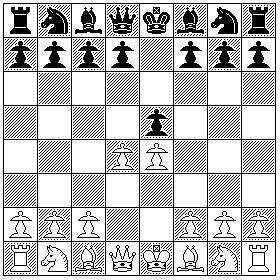
Danish Gambit 1. P-K4, P-K4 2. P-Q4, PxP 3. P-QB3
e4, e5 d4, exd4 c3
P4R, P4R P4D, PxP P3AD
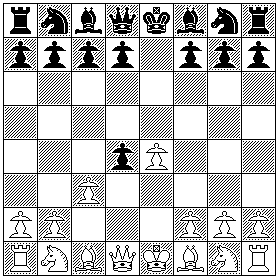
Allgaier Gambit 1. P-K4, P-K4 2. P-KB4, PxP 3. N-KB3, P-KN4 4. P-KR4, P-N5 5. N-N5, P-KR3 6. NxP, KxN
e4, e5 f4, exf4 Nf3, g5 h4, g4 Ng5, h6
P4R, P4R P4AR, PxP C3AR, P4CR P4TR, P5C C5C, P3TR CxP RxC
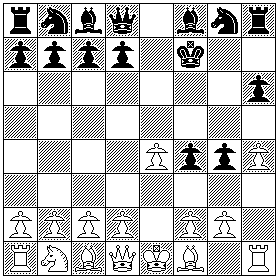
Here, White sacrifices a Knight in order to bring Black's King out into the open.
Allgaier-Kieseritzky Gambit 1. P-K4, P-K4 2. P-KB4, PxP 3. N-KB3, P-KN4 4. P-KR4, P-N5 5. N-K5
Kieseritzky Gambit e4, e5 f4, exf4 Nf3, g5 h4, g4 Ne5
P4R, P4R P4AR, PxP C3AR, P4CR P4TR, P5C C5R
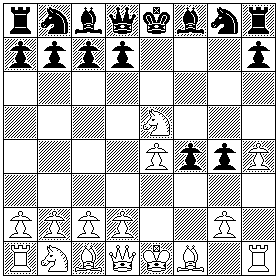
Falkbeer Counter-Gambit 1. P-K4, P-K4 2. P-KB4, P-Q4
e4, e5 f4, d5
P4R, P4R P4AR, P4D
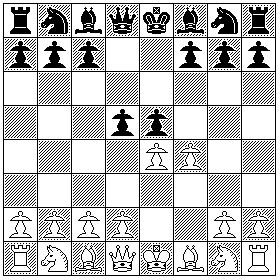
Philidor's Defence 1. P-K4, P-K4 2. N-KB3, P-Q3
e4, e5 Nf3, d6
P4R, P4R C3AR, P3D
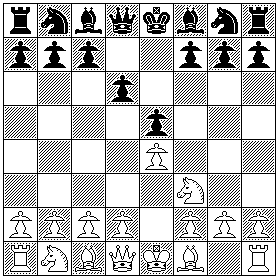
Latvian Gambit 1. P-K4, P-K4 2. N-KB3, P-KB4
(Greco Counter-Gambit) e4, e5 Nf3, f5
P4R, P4R C3AR, P4AR
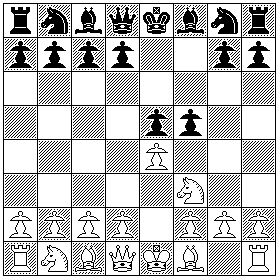
Italian Game 1. P-K4, P-K4 2. N-KB3, N-QB3
e4, e5 Nf3, Nc6
P4R, P4R C3AR, C3AD
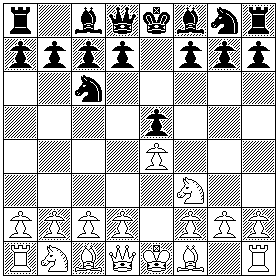
Scotch Game 1. P-K4, P-K4 2. N-KB3, N-QB3 3. P-Q4, PxP
e4, e5 Nf3, Nc6 d4, exd4
P4R, P4R C3AR, C3AD P4D, PxP
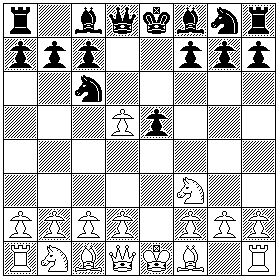
Ponziani's Opening 1. P-K4, P-K4 2. N-KB3, N-QB3 3. P-B3 (Staunton's Opening) e4, e5 Nf3, Nc6 c3 (English Knight's Game) P4R, P4R C3AR, C3AD P3A
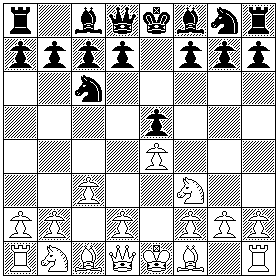
This is a very old Chess opening. It is not currently considered advisable.
Three Knights' Game 1. P-K4, P-K4 2. N-KB3, N-QB3 3. N-B3
e4, e5 Nf3, Nc6 Nc3
P4R, P4R C3AR, C3AD C3A
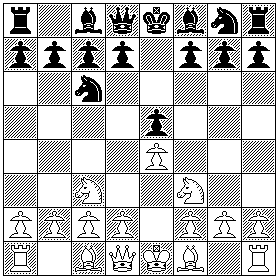
Four Knights' Game 1. P-K4, P-K4 2. N-KB3, N-QB3 3. N-B3, N-B3
e4, e5 Nf3, Nc6 Nc3, Nf6
P4R, P4R C3AR, C3AD C3A, C3A
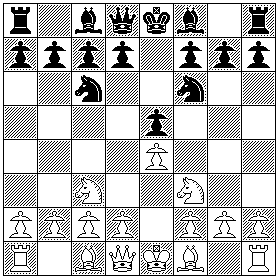
Guioco Piano 1. P-K4, P-K4 2. N-KB3, N-QB3 3. B-B4, B-B4
e4, e5 Nf3, Nc6 Bc4, Bc5
P4R, P4R C3AR, C3AD A4A, A4A
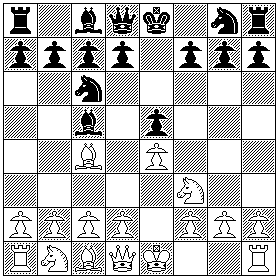
Two Knights' Defense 1. P-K4, P-K4 2. N-KB3, N-QB3 3. B-B4, N-B3
e4, e5 Nf3, Nc6 Bc4, Nf6
P4R, P4R C3AR, C3AD A4A, C3A
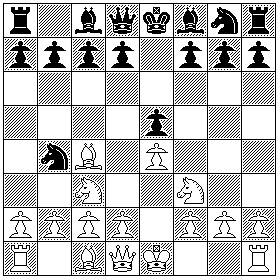
Felgatello Attack 1. P-K4, P-K4 2. N-KB3, N-QB3 3. B-B4, N-B3 4. N-N5, P-Q4 5. PxP, NxP 6. NxP/B7
(Fried Liver Attack) e4, e5 Nf3, Nc6 Bc4, Nf6 Ng5, d5 exd5, Nxd5 Nxf7
P4R, P4R C3AR, C3AD A4A, C3A C5C, P4D PxP NxP CxPA
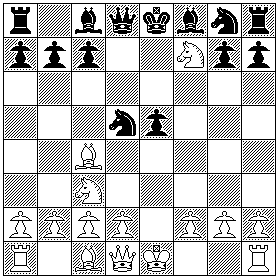
This sacrifices a Knight to expose the Black King.
Ruy Lopez 1. P-K4, P-K4 2. N-KB3, N-QB3 3. B-N5
e4, e5 Nf3, Nc6 Bb5
P4R, P4R C3AR, C3AD B5C
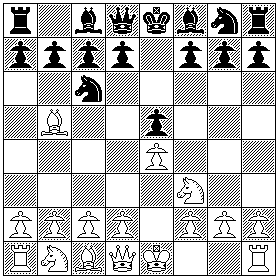
Petroff's Defence 1. P-K4, P-K4 2. N-KB3, N-KB3
e4, e5 Nf3, Nf6
P4R, P4R C3AR, C3AR
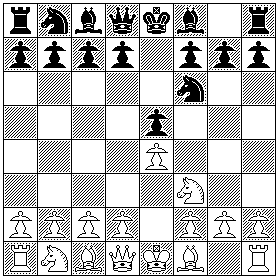
Note that if White and Black continue by bringing out their Queen Knights, the same position as shown above for the Four Knights' Game can be achieved. This is an example of what is termed transposition; as a general rule, the position is assigned to one move sequence because in the case of a different move sequence that could also lead to it, one of the players would have a better move to make instead. Which would lead to the conclusion that 2. ... N-KB3 is inferior to 2. ... N-QB3. In some cases, though, such as this one, either that conclusion is not valid, or at least the difference is very slight.
Vienna Game 1. P-K4, P-K4 2. N-QB3
e4, e5 Nc3
P4R, P4R C3AD
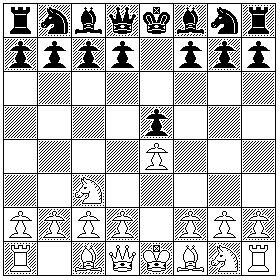
Again, an opening that can transpose to the Four Knights' Game; see the comments above for Petroff's Defence. Here, the apparent conclusion is that 2. N-QB3 is inferior to 2. N-KB3.
Sicilian Defence 1. P-K4, P-QB4
e4, c5
P4R, P4AD
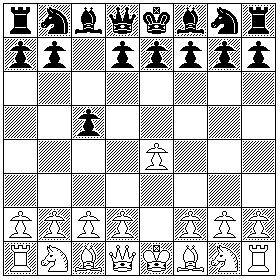
This is the move that refutes 1. P-K4. Serious chess players will tell you that this statement is an outrageous exaggeration, of course. But what I mean is this: books on Chess for beginners will often recommend P-K4 as an opening move, with the intent that the two players will settle down to play a simple tactical game with an opening such as the Guioco Piano.
But in the typical chess club, one is likely to find opponents who will play the Sicilian Defence instead, which, although it also leads to a tactical game, will go into waters too deep for beginning players. So, to avoid a frustrating experience, perhaps in addition to Reinfeld, the beginning player might be advised to read, say, Michael Stean's Simple Chess at an earlier stage in his development, so as to be able to draw with P-Q4 against superior players.
Incidentally, one might mention that it was the book Modern Ideas in Chess by Richard Réti that quoted a passage by Savielly Tartakower in his booklet Am Baum der Schacherkenntnis (The Tree of Chess Knowledge), describing the outragous beliefs and claims of some in the Hypermodern school of Chess, ending by attributing to Gyula Breyer the famous statement: "After 1. P-K4, White's game is in its last throes!" - from a pamphlet by him which, so far, has not been located by chess historians.
Dragon Variation 1. P-K4, P-QB4 2. N-KB3, P-Q3 3. P-Q4, PxP 4. NxP, N-KB3 5. N-B3, P-KN3
e4, c5 Nf3, d6 d4, cxd4 Nxd4, Nf6 Nc3, g6
P4R, P4AD C3AR, P3D P4D, PxP CxP, C3AR C3A, P3CR
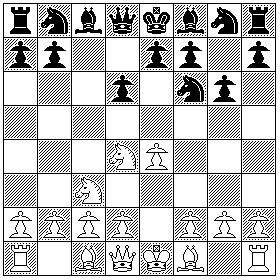
This position and move sequence is only one example of an opening classed as belonging to the Dragon Variation of the Sicilian Defence; different move orders and slightly different positions also belong to the Dragon Variation.
Caro-Kann 1. P-K4, P-QB3
e4, c6
P4R, P3AD
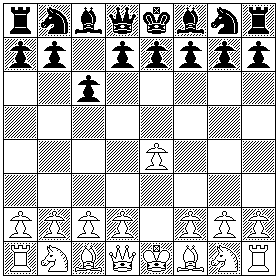
Alekhine's Defence 1. P-K4, N-KB3
e4, Nf6
P4R, C3AR
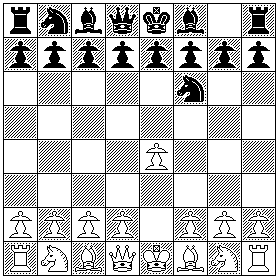
As the obvious response to this opening is 2. P-K5, the threat to White's King Pawn doesn't seem to gain anything for Black, and instead White gets additional control of the center. Thus, many authors do not recommend this opening (specifically, for Black to make the move 1 ... N-KB3 in the given situation); however, it is still used with success in current Grandmaster play on occasion.
Queen's Gambit 1. P-Q4, P-Q4 2. P-QB4
(Aleppo Gambit) d4, d5 c4
P4D, P4D P4AD
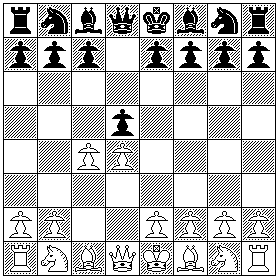
This opening brings a threat that can't be ignored. If Black's next move doesn't respond to that threat, White could then move Q-R4 check. (While the King can't move out of check, either of two Pawns, a Bishop, a Knight, or the Queen could be interposed.)
Albin Counter-Gambit 1. P-Q4, P-Q4 2. P-QB4, P-K4
d4, d5 c4, e5
P4D, P4D P4AD, P4R
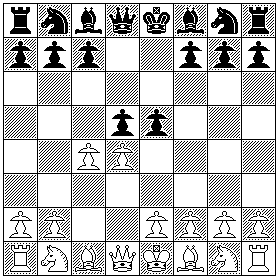
And this opening illustrates one possible response by Black to that threat. Instead of preventing the check completely by blocking it, the final Black move here, P-K4, only creates an escape route for the King. But while its defensive effect is limited, it also has a large offensive effect, as now the threat from White is replied to with a similar threat from Black: unless White's move reacts to that threat, Black may now move B-QN5 check. (Again, the King can't move out of check, and there are also no Pawns to be interposed, but a Knight, a Bishop, or the Queen may be interposed.)
Queen's Gambit Declined 1. P-Q4, P-Q4 2. P-QB4, P-K3
d4, d5 c4, e6
P4D, P4D P4AD, P3R
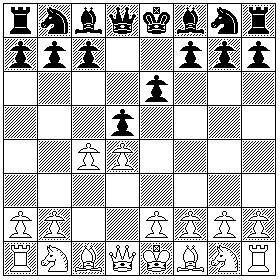
Tarrasch Defence 1. P-Q4, P-Q4 2. P-QB4, P-K3 3. N-QB3, P-QB4
d4, d5 c4, e6 Nc3, c5
P4D, P4D P4AD, P3R C3AD, P4AD
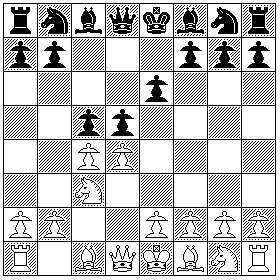
Chigorin's Defense 1. P-Q4, P-Q4 2. P-QB4, N-QB3
d4, d5 c4, Nc6
P4D, P4D P4AD, C3AD
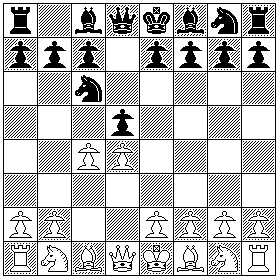
This opening is distrusted on general principles, because it is felt that Black is not doing enough to maintain control of the center, but it has been used with success in current Grandmaster play.
Dutch Defence 1. P-Q4, P-KB4
d4, f5
P4D, P4AR
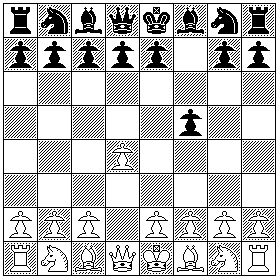
Benoni Counter-Gambit 1. P-Q4, P-QB4
d4, c5
P4D, P4AD
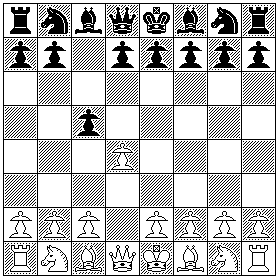
Budapest Defence 1. P-Q4, N-KB3 2. P-QB4, P-K4
d4, Nf6 c4, e5
P4D, C3AR P4AD, P4R
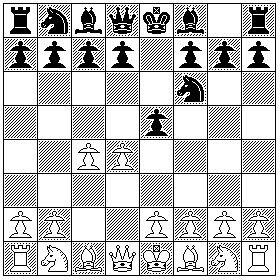
Nimzo-Indian Defence 1. P-Q4, N-KB3 2. P-QB4, P-K3 3. N-QB3, B-N5
d4, Nf6 c4, e6 Nc3, Bb4
P4D, C3AR P4AD, P3R C3AD, A5C
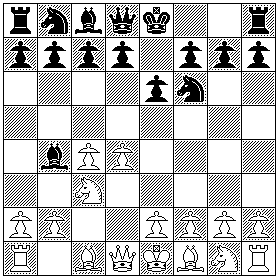
This is an opening that has been quite popular in grandmaster play. However, this opening and the other related openings were unknown and unnamed before the 20th Century.
Queen's Indian Defence 1. P-Q4, N-KB3 2. P-QB4, P-K3 3. N-KB3, P-QN3
d4, Nf6 c4, e6 Nf3 b6
P4D, C3AR P4AD, P3R C3AR, P3CD
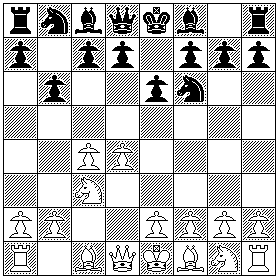
Old Indian 1. P-Q4, N-KB3 2. P-QB4, P-Q3
(Tchigorin's Defence) d4, Nf6 c4, d6
P4D, C3AR P4AD, P3D
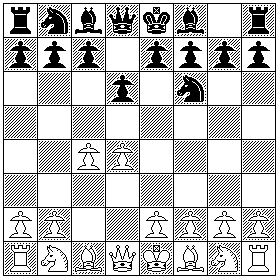
This opening was formerly known as Tchigorin's (or Chigorin's) Defence, but that is confusing as another opening, also shown here, is now generally known by that name.
Benoni Defence 1. P-Q4, N-KB3 2. P-QB4, P-QB4 3. P-Q5
d4, Nf6 c4, c5 d5
P4D, C3AR P4AD, P4AD P5D
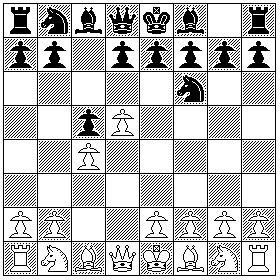
King's Indian Defence 1. P-Q4, N-KB3 2. P-QB4, P-KN3
d4, Nf6 c4, g6
P4D, C3AR P4AD, P3CR
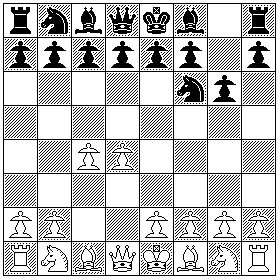
Indian Opening 1. P-KN3, P-K3 2. P-Q3
g3, e6 d3
P3CR, P3R P3D
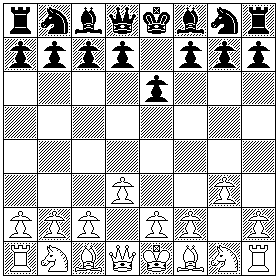
This is an opening that does not seem to be played at present; it is included to clear up any confusion with the Old Indian that its name might cause.